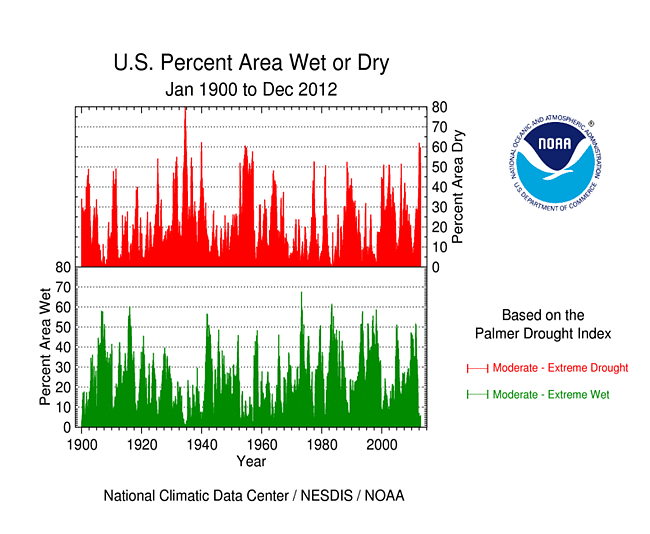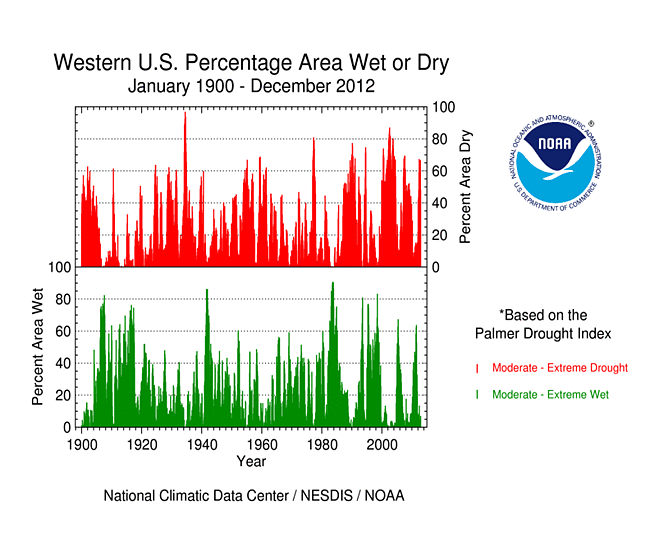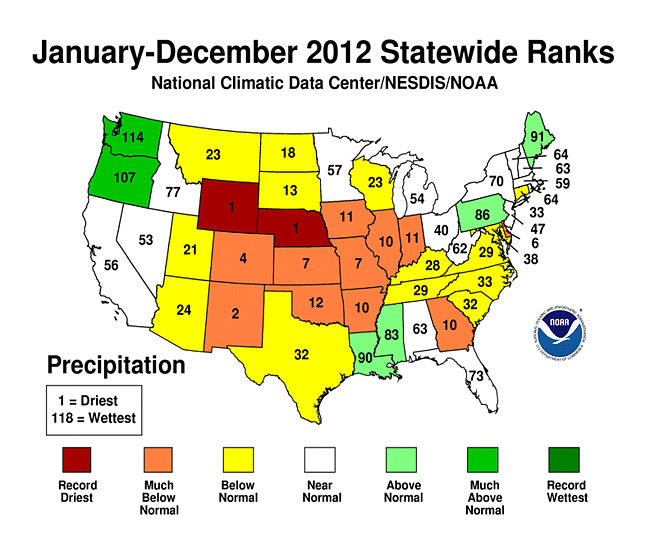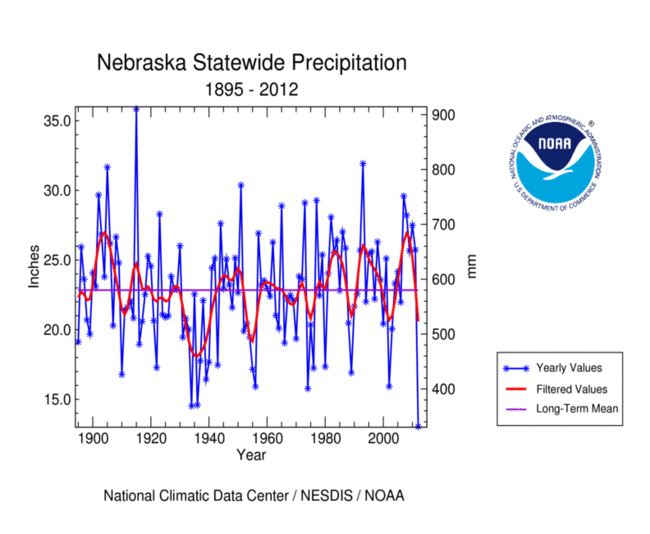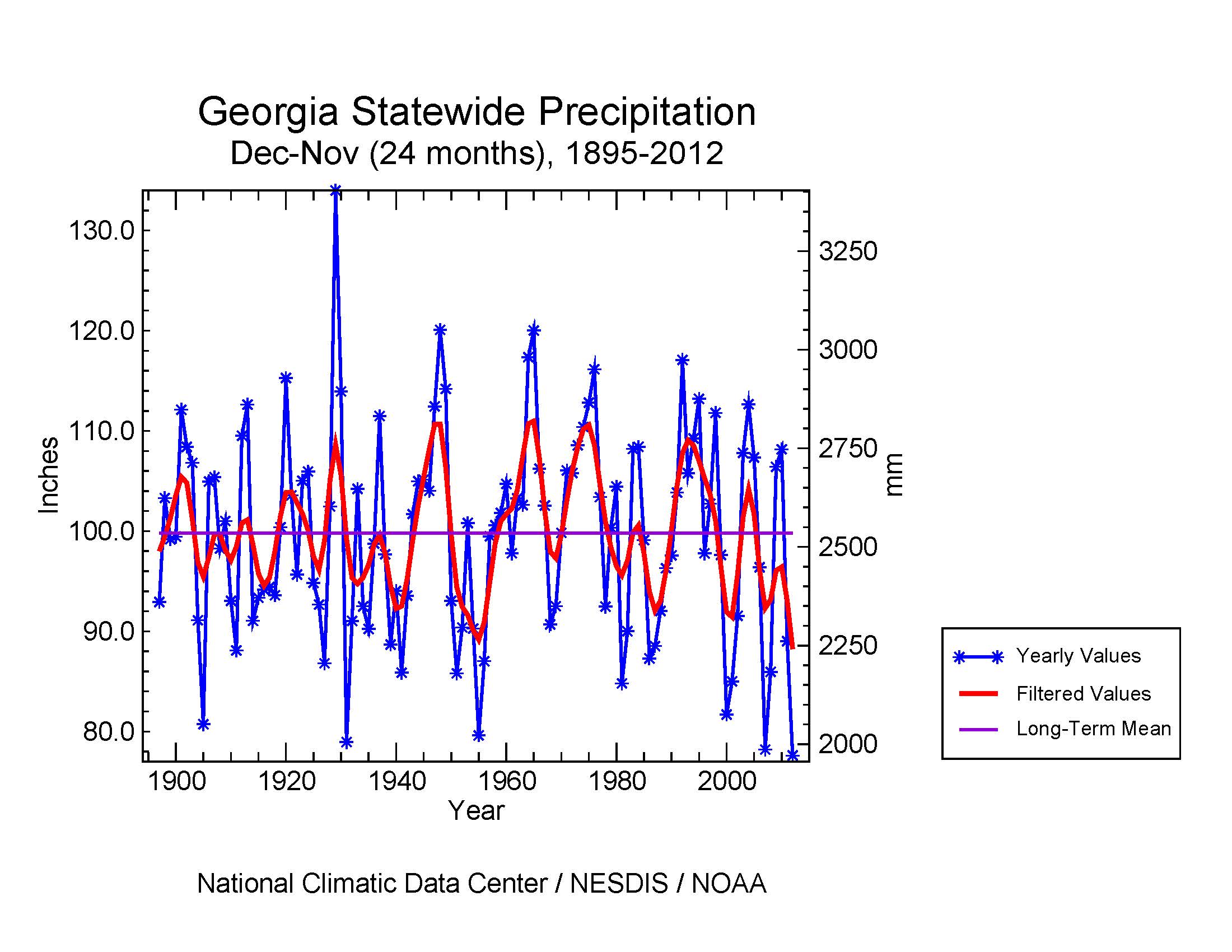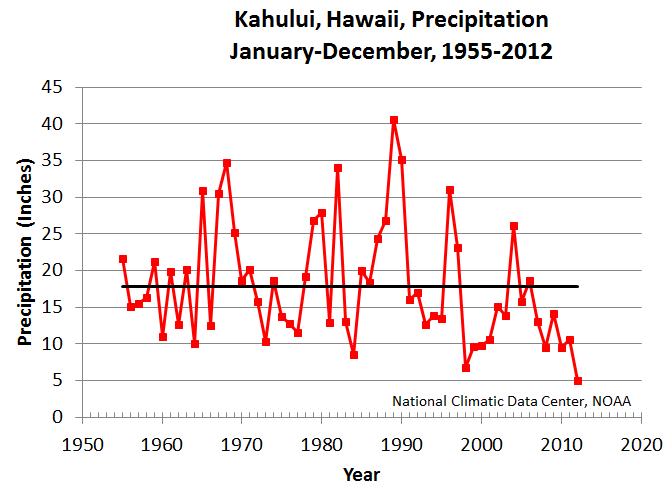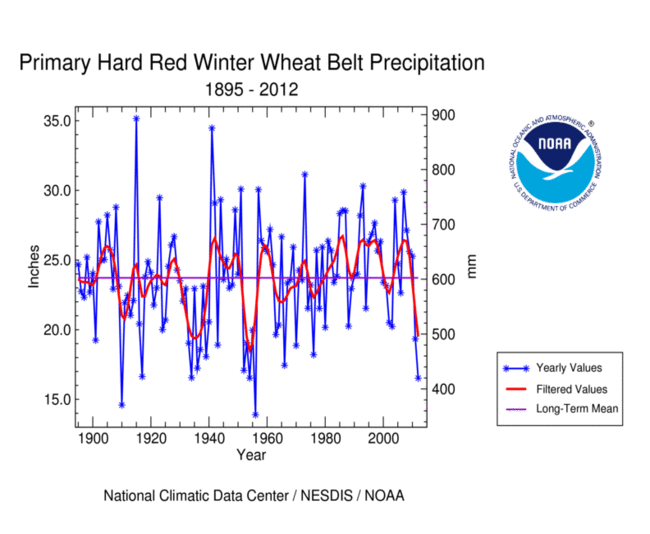The data presented in this drought report are preliminary. Ranks, anomalies, and percent areas may change as more complete data are received and processed.
|
Contents Of This Report: |
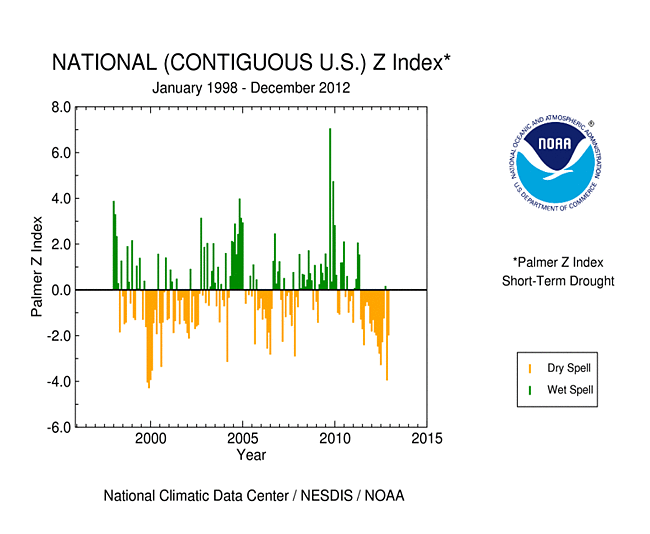
|
National Drought Overview
On a month-by-month basis, 2012 was characterized by large areas of dry and, earlier in the year, large areas of wet weather. Eight months (all except January, February, October, and December) had ten percent or more of the country experiencing very dry (at the tenth percentile of the historical record or drier) precipitation anomalies, with five months (May, June, August, September, and November) having more than a fifth (20 percent) of the country very dry. June and November had a third of the country very dry. The percent area very wet (monthly precipitation totals at the 90th percentile of the historical record or wetter) stayed under ten percent for all but one of the months in the year, with March having the largest percent area very wet (16%). When averaged together, the wet and dry anomalies resulted in the 20th driest February, 23rd driest May, 10th driest June, 22nd driest July, and 8th driest November, nationally, in the 1895-2012 record. Large areas of the country also experienced unusually warm conditions. Ten percent or more of the contiguous U.S. was very warm (monthly temperatures at the 90th percentile of the historical record or warmer) during every month except October. More than a fourth (25%) was very warm during eight months, with July (60%) and March (75%) having more than half of the country very warm. This persistent and anomalous heat resulted in the warmest month ever (July 2012), ranked 2012 as the warmest year on record, and (especially during the growing season) increased evaporation and intensified local drought conditions.
An important feature of the weather conditions in 2012 was the persistence of the areas of dryness and warm temperatures, the magnitude of the extremes, and the large area they encompassed. Dry weather affected parts of the West almost every month, especially the Intermountain Basin during April-July, the Southwest during April-June and October-November, and the Rockies during March-November. The Central Great Plains were plagued by dryness much of the year (especially March-November), with dryness especially acute during the summer across the Plains (June-August). Dry weather dominated across the Central Plains to Midwest agricultural areas during the critical May-July growing season, but the dryness lasted longer in parts of this region (for example, the Midwest during February-July). August-September saw very dry weather from the Pacific Northwest, across the Northern Rockies and Central to Northern Plains, and into the western Great Lakes. Dry weather afflicted the eastern U.S. early in the year, with the Southeast dry during January-April and the Northeast during February-April. Large areas of the country were very dry during May-June (from the West Coast to the Ohio and Tennessee valleys), August-September (from the Pacific Northwest to the western Great Lakes), and November (from the Southwest and Southern Plains to the Northeast and Southeast).
|
Standardized Precipitation Index maps: |
Standardized Temperature Index maps: |
Palmer Z Index maps: |
The hot temperatures exacerbated the impact of the dry weather. When maps of the dryness (Standardized Precipitation Index [SPI]) are compared to maps of the Palmer Z Index (which incorporates the effects of both dryness and heat), larger areas of monthly drought are evident on the Z Index maps for March (SPI, Z Index), April (SPI, Z Index), May (SPI, Z Index), July (SPI, Z Index), and November (SPI, Z Index).
|
U.S. Drought Monitor maps: |
Palmer Drought Severity Index maps: |
The year started out with 31.9 percent of the contiguous U.S. in moderate to exceptional drought (based on the U.S. Drought Monitor [USDM]) manifested in two drought epicenters — areas of moderate to exceptional drought in the Southern Plains and moderate to extreme drought in the Southeast — with areas of moderate to severe drought in the Upper Mississippi Valley and moderate drought in the Far West. As the year progressed, the western drought expanded to link with the Southern Plains drought area and new drought areas developed along the East Coast, pushing the national drought area to 38.2 percent by May 1. Dryness during the late spring began to take its toll in the agricultural heartland by summer as drought intensified and expanded to cover much of the country from the Central Rockies to the Ohio Valley, and the Mexican border to the Canadian border, by the end of August. This solid mass of drought, which stretched from border to border and (by now) West Coast to Mississippi River, persisted through the fall. The percentage area in drought peaked at about 65.5 percent on September 25 (a new high in the 1999-2012 USDM record) and ended the year at 61.1 percent. The percent area of the contiguous U.S. in the worst drought categories (D3-D4, extreme to exceptional drought) peaked at 24.1 percent on August 7, which is also a record.
The percent area* of the contiguous U.S. experiencing moderate to extreme drought (based on the Palmer Drought Index) started the year at about 22.9 percent, grew steadily to a peak of about 61.8 percent during the summer, then contracted slightly during the fall, ending the year at about 51.8 percent. The Palmer Drought Index data go back 113 years.
*This drought statistic is based on the Palmer Drought Index, a widely used measure of drought. The Palmer Drought Index uses numerical values derived from weather and climate data to classify moisture conditions throughout the contiguous United States and includes drought categories on a scale from mild to moderate, severe and extreme.
[top]
Regional Drought Overview
The year began with drought epicenters in the Southern Plains, Southeast, Upper Midwest, Far West, and Hawaii. As winter ended and spring began, dryness in the West spread to join the Plains and West drought areas while the Southeast drought crept up the East Coast. The spring months were quite dry with drought spreading or pockets of drought developing in several regions. The summer months were extremely dry across a large part of the central U.S., with the result being a merging of the drought epicenters in the West, Plains, and Midwest into one large drought area stretching from the West Coast to the Great Lakes. Beneficial autumn rains helped portions of the Midwest recover from drought, but dryness continued in the Plains where drought intensified. By the end of 2012, three drought epicenters remained — Hawaii, the Southeast, and one large area of drought stretching from the southern California coast across the West and Great Plains to the Midwest, with the worst drought conditions focused on the Plains states.
The dry weather (which lowered moisture supplies), coupled with intense spring and summer heat (which increased evapotranspiration and, thus, moisture demand), depleted soil moisture, lowered streamflow (May, June, July, August), reservoir and stock pond levels, and ravaged crops and livestock. By year's end, low river levels threatened commerce on the vital Mississippi River shipping lanes.
West:

The percent area of the West in moderate to exceptional drought steadily grew during 2012, peaking at 77% in October.
The West began the hydrologic year (water year, October-September) on a dry note, with below-normal precipitation and snowpack water content. As the wet season (October-April) ended, the southern portions of the West had significant precipitation and snow water content deficits, while the northern areas were not as bad off. Continued dryness and intense heat during the spring and summer caused numerous wildfires to break out, with Colorado especially hard hit. Record heat and near-record dryness occurred in the state, with April-June 2012 ranking as the hottest and third driest April-June on record. Wyoming was record dry for several time scales, including June-August, April-August, March-August, June-September, May-September, April-September, and several others. Utah was record dry in June and April-June. A total of four states (Colorado, Nevada, Utah, Wyoming) ranked in the top ten driest category for April-June, six states were in the top ten driest for January-June, and three for January-November, including Colorado and Wyoming (which were record dry) and New Mexico (second driest). The weather pattern shifted during summer and early autumn, bringing much-needed precipitation to the southern areas but drying out the northern states. Five western states (Idaho, Montana, Oregon, Washington, Wyoming) ranked in the top ten driest category for July-September, with Montana having the driest August-September and July-September on record. When last year's dryness is combined with this year's dryness, the last two years (December 2010-November 2012) in New Mexico ranked as the driest such 24-month period on record. For January-December 2012, three states (Wyoming [driest], New Mexico [second driest], Colorado [fourth driest]) ranked in the top ten driest category and three other states (Arizona, Montana, Utah) ranked in the driest third of the historical record.
The percent area of the West in moderate to exceptional drought, as measured by the USDM, steadily grew during 2012, peaking at about 77.2 percent in October. Based on the Palmer Drought Index, which goes back to the beginning of the 20th century, moderate to extreme drought peaked at about 67.2 percent of the West during June. Both of these numbers were surpassed by the 2002-2003 drought and (for the Palmer index) earlier droughts.
Great Plains and Midwest:

The percent area of the High Plains (Kansas to North Dakota) in moderate to exceptional drought skyrocketed during summer 2012, covering nearly the entire High Plains region by October.
Last year, drought was centered in the Southern Plains. This year, the entire Plains region was afflicted by drought with a significant part of the Midwest sharing the misery. Dryness affected the Northern Plains during March, the Southern Plains during April, and the Southern to Central Plains during May, with different portions of the Midwest affected during each of those months. But that was just a prelude to even worse conditions. The entire Plains and Midwest were baked and moisture-starved during June and July. Beneficial rains came to parts of the Midwest and Southern Plains during August and September, and to the Northern Plains and Midwest in October, but widespread dry conditions returned in November.
Record dryness occurred for several states in August and September. The persistence of drought gave several states record dry seasons, including Arkansas (April-June and other seasons), Kansas (May-July), Nebraska (June-August and other seasons), and South Dakota (July-September). Six states in the Plains and Midwest (Arkansas, Indiana, Iowa, Kansas, Missouri, Nebraska) ranked in the top ten driest category for January-November, with Nebraska having the driest January-November on record. For January-December 2012, five Great Plains and Midwest states ranked in the top ten driest category, including Nebraska which had the driest year on record.
The percent area of the Great Plains and Midwest in moderate to exceptional drought, as measured and defined by the USDM regions, rapidly increased during 2012. Nearly all of the Northern Plains was enveloped in drought by October, which is a record in the 13-year USDM history. Drought coverage also rapidly increased in the Midwest, peaking at about 73.7 percent in July, which is also a USDM record. In early 2012, the Southern Plains was recovering from the 2011 drought. The percent area in moderate to exceptional drought decreased to a low of about 32.3 percent in May 2012 before expanding again to peak at about 73.7 percent in July.
Southeast to Northeast:

The percent area of the Southeast in moderate to exceptional drought oscillated up and down during 2012.
The precipitation pattern for the eastern U.S. fluctuated between wet and dry during 2012. The Southeast started the year on the dry side, with January-February ranking in the driest third of the historical record for several states. February-April was dry for the Northeast, with Connecticut having the driest February-April on record and most other states ranking in the top ten driest category. Three southeastern states (Alabama, Georgia, and Tennessee) ranked in the top ten driest category for April. The weather patterns, which brought drought to the Great Plains and Midwest during the late spring and summer, doused many of the eastern states with beneficial rainfall during this time. Although helpful, the rains were not enough to erase several years' of deficits in the Southeast. November was dry for all eastern states, with most ranking in the top ten driest category. The cumulative impact of the 2012 precipitation deficits gave Delaware the fourth driest January-November and Georgia, the epicenter of the Southeast drought, the eighth driest January-November. For the year (January-December), several states along the eastern seaboard were drier than normal, with Georgia ranking tenth driest and Delaware having the sixth driest year on record. The prolonged dryness in parts of the Southeast gave Georgia the driest December-November 24-month period (December 2010-November 2012) on record.
Parts of the Southeast have been in drought for the last two years. The percent area of the Southeast in moderate to exceptional drought, as measured by the USDM, hovered around 50 to 65 percent during the first five months of the year, then contracted during the summer and fall before expanding again at the end of the year. It peaked at about 69 percent at the beginning of May.
Hawaii and other Pacific Islands:
Drought in Hawaii was resurgent in 2012, with 47.4 percent of the state affected by moderate to exceptional drought on January 3, growing to 73.2 percent by December 4. The state has been in drought for the last four years, with the December 4, 2012 peak approaching the peaks of 2008-2010. Several locations had record to near-record dry conditions in 2012, with Kahului recording the lowest rainfall for the year based on data from 1955-2012, and Honolulu having the fifth driest and Hilo eighth driest year in their 1950-2012 records. Annual rainfall at other U.S.-affiliated Pacific Island stations during 2012 was near or above normal.
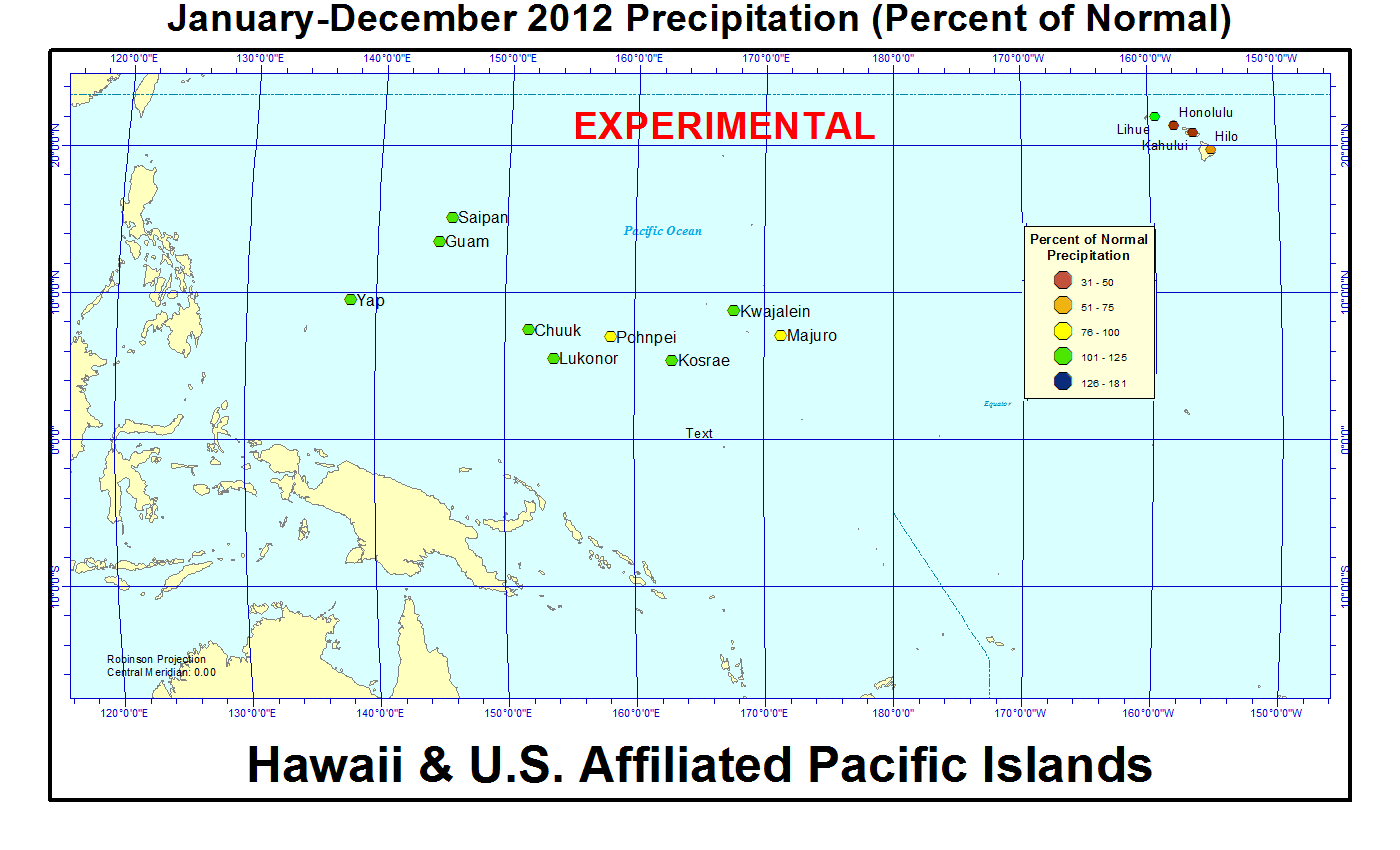
Agricultural Belts:
The spatial pattern of drought this year closely overlaid the agricultural area of the U.S. heartland, and the excessive temperatures and lack of rain during the critical growing season severely reduced corn and soybean crop yield. The Primary Corn and Soybean agricultural belt, collectively, experienced the warmest and seventh driest March-August in 2012, resulting in the fourth most severe Palmer Z Index for the season (behind 1936, 1934, and 1988). The extreme severity of the dryness and evapotranspiration demand over the growing season resulted in a rapid increase in the percent area of this agricultural belt experiencing moderate to extreme drought (as defined by the Palmer Drought Index) and moderate to exceptional drought (for the Midwest and High Plains as defined by the USDM). By August 2012, about 89.3 percent of the Primary Corn and Soybean Belt was experiencing moderate to extreme drought (based on the Palmer Drought Index), surpassing all previous droughts except those in 1988 and the 1930s. The August-October rains in the eastern part of this region were beneficial and helped reduce the intensity of the drought there, but they did little to shrink the overall drought area for the entire region, with the value down to only 54.9 percent by the end of the year. By year's end, January-December 2012 ranked as the tenth driest year on record.
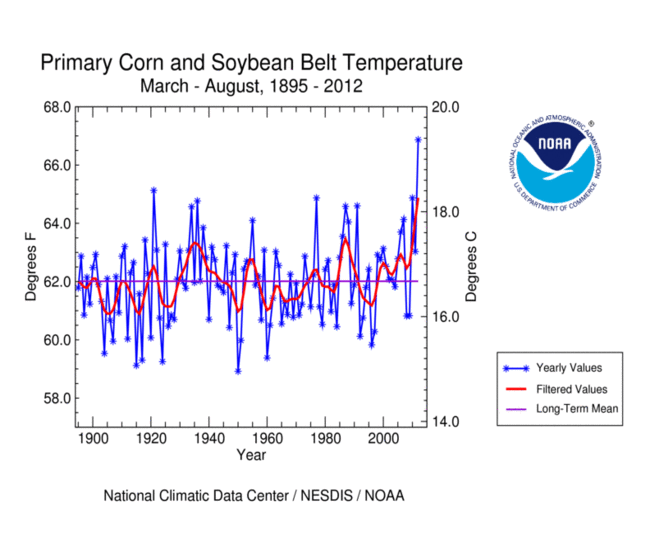
|

|

|

|
The growing season (October-April) has started out on a dry note for much of the Winter Wheat agricultural belt. October-December 2012 ranked as the 27th driest October-December in the 1895-2012 record, with November 2012 ranking as the 13th driest November. For the smaller Primary Hard Red Winter Wheat belt, November 2012 ranked 23rd driest and October-December tenth driest. By year's end, January-December 2012 ranked as the ninth driest year on record for the Winter Wheat belt and third driest for the Primary Hard Red Winter Wheat belt.
River Basins:
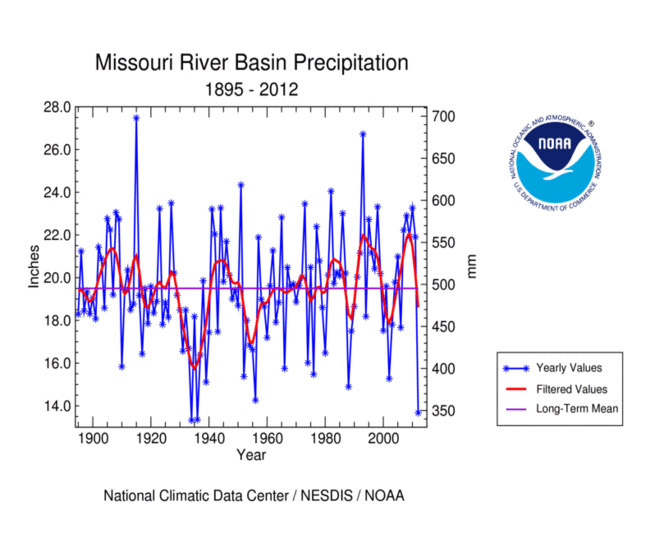 |
 |
| River Basin | Jan-Dec | Oct-Dec |
|---|---|---|
| Pacific Northwest | 11th wettest | 10th wettest |
| California | 56th driest | 36th wettest |
| Great Basin | 41st driest | 35th wettest |
| Lower Colorado | 24th driest | 33rd driest |
| Upper Colorado | driest | 29th driest |
| Rio Grande | 10th driest | 5th driest |
| Texas Gulf Coast | 41st driest | 4th driest |
| Arkansas-White-Red | 9th driest | 11th driest |
| Lower Mississippi | 48th driest | 35th driest |
| Missouri | 3rd driest | 37th driest |
| Souris-Red-Rainy | 35th driest | 31st wettest |
| Upper Mississippi | 10th driest | 59th driest |
| Great Lakes | 54th driest | 26th wettest |
| Tennessee | 38th driest | 59th driest |
| Ohio | 27th driest | 55th wettest |
| South Atlantic-Gulf | 53rd driest | 46th driest |
| Mid-Atlantic | 46th driest | 37th wettest |
| New England | 38th wettest | 38th wettest |
Several river basins have experienced unusually dry conditions during 2012, with the Upper Colorado having the driest year in the 1895-2012 record. As noted by the Midwest Regional Climate Center, drought has contributed to low water issues from the Great Lakes to the Missouri and Mississippi rivers, with navigation on the Mississippi River continuing to be a concern through December. The Missouri River basin had the third driest year in 2012 (behind 1934 and 1936), the Arkansas-White-Red River basin had the ninth driest year, and the Upper Mississippi and Rio Grande both ranked tenth driest. For the Mississippi River and all of its tributaries north of Memphis, Tennessee, 2012 ranked as the sixth driest year on record (behind 1934, 1936, 1976, 1988, and 1930). The aggregate PDSI for the Missouri basin reached the lowest value since the 1950s, while the aggregate PDSI for the broader Mississippi and its tributaries was the lowest since only 1988.
Historical Analogs:
As seen in the National Drought Overview section, the percent area of the contiguous U.S. experiencing moderate to exceptional drought (based on the USDM) reached 65.5 percent in September, a record in the 13-year USDM history. The percent area of the contiguous U.S. experiencing moderate to extreme drought, based on the Palmer Drought Index (which goes 113 years), peaked at about 61.8 percent in July. This is only slightly larger than the peak percent area values of the 1950s drought decade and is the largest value since December 1939. So, in terms of total area covered by drought, the 2012 drought closely resembles the 1950s droughts.
The geographical pattern (location and intensity of dryness) of the 2012 drought can be compared to the patterns of previous droughts by using statistical tools such as the correlation coefficient and mean absolute difference. In the two tables below, the 2012 climate conditions (Palmer Z Index, Palmer Hydrological Drought Index [PHDI], temperature [Temp], precipitation [Precip]) were compared two different ways. In the table to the left, each month (January-December) of 2012 was compared individually to the previous years (1900-2011) to find the year with the closest match to each individual month (January closest match to January 2012, and February closest match to February 2012, and March closest match to March 2012, etc.). In the table to the right, the 2012 annual average values were compared to the annual average values for each of the previous years. No consistent pattern in historical analogs can be found in the monthly comparison (left-hand table) due to normal month-to-month variability (climatic noise). However, when the month-to-month variability is averaged out (by computing annual values as in the right-hand table), a consistent pattern becomes evident — the drought years 1955 and 1956 are the closest historical analogs to the geographical pattern of drought in 2012, and 1998 (the second warmest year on record) and 2006 (third warmest year on record) are the closest historical analogs to 2012 for the spatial temperature pattern.
Top 5 Analog Years to 2012 (each month January-December compared individually)
|
Top 5 Analog Years to 2012 (annual values compared )
|
[top]
Contacts & Questions
 NOAA's National Centers for Environmental Information
NOAA's National Centers for Environmental Information


